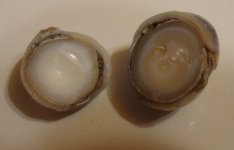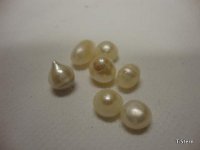TomMStern
New Member
- Joined
- Sep 25, 2008
- Messages
- 10
Hi everyone,
My father, Dr. T.K. Stern, recently went on a trip to Hong Kong and found some "antique" pearls in a shop. Apparently he had been looking around when he found that the owner had a little bag of discarded old pearls sitting in one of the shelves. Allegedly they were very old and came from some fancy tiara and he ended up purchasing them.
Whatever their real age or story may be, they have definitely experienced a substantial level of decay, with layers of nacre disintegrating, etc. Very, very bad shape. So, to clean them up, I have developed a working and polishing process to remove the decaying layers and restore the luster. I did this to several of the pearls, making sure to try and preserve their original shape.
In this process, I discovered that after removing several layers with decay in between, I would hit what I thought was a good layer of nacre, which I would then expose to finish the restored pearl. However, after a few more, I discovered that several finished ones, where I had worked to the good layer, appeared to be the same standard size.
I am now suspicious that these are not antique, but may just be some very mistreated bead cultured pearls where I have ground the nacre down to the bead.- Possible freshwater pearls used as bead inserts...
In the photos attached, I include two cross section shots and also some shots of the pearls after working.
I would appreciate everybody's feedback on this. I've seen a lot of x-rays and cross sections/ cores of new pearls, but I am afraid to reach conclusions on these because I am not sure of their age, and what the duration of their age could imply in regard to their nacre formations.
If it remains questionable, I will take take the gamble of having them tested. If they are natural, coupled with their cool background story, I think they will be very valuable.
Ok, Thanks to everyone.
My father, Dr. T.K. Stern, recently went on a trip to Hong Kong and found some "antique" pearls in a shop. Apparently he had been looking around when he found that the owner had a little bag of discarded old pearls sitting in one of the shelves. Allegedly they were very old and came from some fancy tiara and he ended up purchasing them.
Whatever their real age or story may be, they have definitely experienced a substantial level of decay, with layers of nacre disintegrating, etc. Very, very bad shape. So, to clean them up, I have developed a working and polishing process to remove the decaying layers and restore the luster. I did this to several of the pearls, making sure to try and preserve their original shape.
In this process, I discovered that after removing several layers with decay in between, I would hit what I thought was a good layer of nacre, which I would then expose to finish the restored pearl. However, after a few more, I discovered that several finished ones, where I had worked to the good layer, appeared to be the same standard size.
I am now suspicious that these are not antique, but may just be some very mistreated bead cultured pearls where I have ground the nacre down to the bead.- Possible freshwater pearls used as bead inserts...
In the photos attached, I include two cross section shots and also some shots of the pearls after working.
I would appreciate everybody's feedback on this. I've seen a lot of x-rays and cross sections/ cores of new pearls, but I am afraid to reach conclusions on these because I am not sure of their age, and what the duration of their age could imply in regard to their nacre formations.
If it remains questionable, I will take take the gamble of having them tested. If they are natural, coupled with their cool background story, I think they will be very valuable.
Ok, Thanks to everyone.



